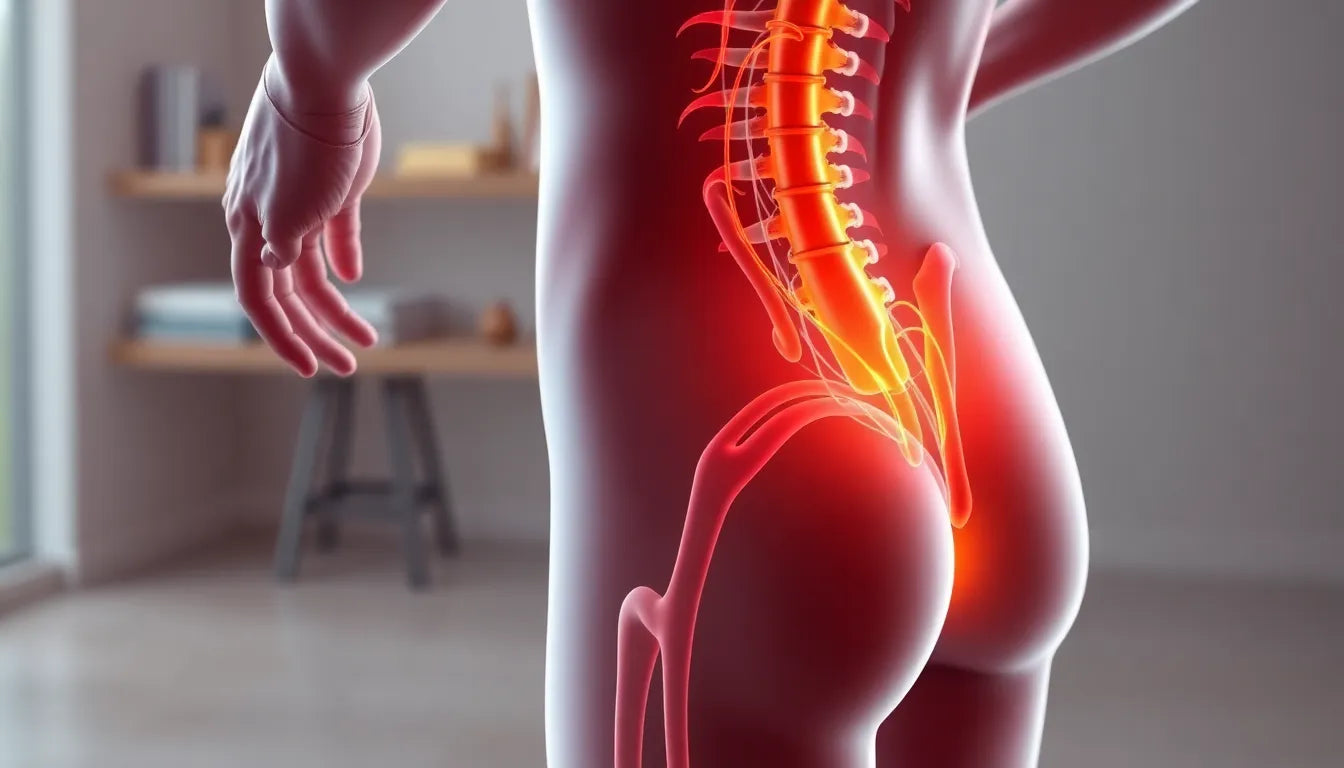Understanding the intricacies of rehabilitation after a herniated disc in the lower back is crucial for anyone navigating this challenging condition. A herniated disc occurs when the soft inner gel of a spinal disc pushes through a tear in its tougher exterior. This can be caused by various factors, including age-related degeneration, sudden strain, or improper lifting techniques. Such an injury can lead to severe pain, numbness, or weakness in the lower back and legs, significantly impacting daily activities and quality of life.
understanding herniated discs in the lower back
The prevalence of herniated discs in the lower back is notable, affecting a substantial portion of the adult population at some point in their lives. The condition can disrupt work, hobbies, and even simple daily tasks, making effective rehabilitation essential. Without proper care and rehabilitation, a herniated disc can lead to chronic pain and long-term disability, underscoring the importance of addressing the issue promptly and comprehensively.
the journey to recovery
Embarking on the journey to recovery from a herniated disc involves a structured rehabilitation process with clear goals: alleviating pain, restoring function, and preventing future occurrences. The path to rehabilitation is not a one-size-fits-all solution; it requires a multifaceted approach tailored to each individual's needs. This typically includes physical therapy, personalized exercise programs, and lifestyle modifications to support healing and enhance recovery.
Physical therapy is often the cornerstone of rehabilitation for a herniated disc. It focuses on exercises that improve mobility, strengthen the core, and stabilize the spine, all of which are crucial for reducing pain and preventing further injury. A personalized exercise program is designed to address the specific deficits and challenges faced by the individual, ensuring a targeted approach to recovery.
In addition to physical therapy and exercise, lifestyle adjustments play a pivotal role in the rehabilitation process. This may involve ergonomic changes in the workplace or at home, posture correction, and even modifications to daily activities to reduce strain on the lower back. By adopting these comprehensive strategies, individuals can not only manage their current symptoms but also reduce the risk of future disc herniations.
Overall, the journey to recovery from a herniated disc in the lower back is one of commitment and perseverance. With the right combination of therapies and lifestyle changes, individuals can reclaim their quality of life and return to their daily activities with confidence and comfort.
physical therapy: the cornerstone of rehabilitation
Physical therapy stands as the primary pillar in the rehabilitation process for a herniated disc in the lower back. It is designed to not only alleviate pain but also to restore and enhance mobility, strength, and overall functionality. By focusing on a range of active exercise therapies, physical therapy provides a structured pathway to recovery.
One of the key components of physical therapy is the integration of aerobic activities and the McKenzie approach. These exercises are instrumental in reducing pain and improving mobility. Aerobic activities, such as walking or cycling, enhance cardiovascular health while promoting circulation, which aids in healing. The McKenzie method, a well-regarded therapeutic approach, focuses on specific exercises that help centralize pain and improve spinal alignment.
Another critical aspect of physical therapy is the emphasis on core stabilization and motor control exercises (MCEs). These exercises are designed to strengthen the muscles that support the spine, thereby enhancing spinal stability and functional status. By improving core strength, individuals can better manage their symptoms and reduce the risk of future injuries.
combination of modalities for optimal results
For the most effective rehabilitation, a combination of modalities is often recommended. This includes integrating exercise programs with ergonomic adjustments and manual feedback techniques. A personalized approach to rehabilitation ensures that each individual's unique needs and challenges are addressed, leading to optimal recovery outcomes.
Ergonomic programs focus on modifying the environment to reduce strain on the lower back. This can involve adjustments to workstations, seating, and even daily habits to promote better posture and reduce stress on the spine. Manual feedback techniques, often provided by a trained therapist, help guide movements and correct posture during exercises, enhancing their effectiveness.
progressive recovery phases
The rehabilitation process is typically divided into several progressive phases, each with specific goals and focus areas. In the immediate phase, which spans the first 1-2 weeks, the primary goal is to control inflammation and manage pain. Rest, ice, and gentle movements are often recommended to reduce swelling and discomfort.
During the subacute phase, which lasts from 2 to 6 weeks, the focus shifts to introducing exercises and gradually increasing activity levels. This phase is crucial for regaining mobility and strength while continuing to manage pain.
The rehabilitation phase, extending from 6 weeks to 6 months, emphasizes restoring full function and building strength. More intensive exercises are introduced, aiming to enhance endurance and flexibility while preparing the body for a return to normal activities.
In the chronic phase, which occurs beyond 6 months, the focus is on managing any persistent symptoms and implementing strategies to prevent recurrence. This phase may involve ongoing exercise programs, lifestyle modifications, and possibly complementary therapies to maintain progress and prevent future issues.
the role of complementary therapies
Complementary therapies can play a supportive role in the rehabilitation process. Techniques such as heat/cold therapy, massage, acupuncture, and dry needling can be effective adjuncts in managing symptoms and promoting relaxation. These therapies often enhance the overall rehabilitation experience by providing additional pain relief and improving well-being.
Empowering patients with self-management strategies is also a vital component of successful rehabilitation. Educating individuals on how to incorporate exercises into their daily routine, maintain proper posture, and make ergonomic adjustments can significantly enhance recovery outcomes and reduce the likelihood of future disc herniations.
By understanding and implementing these comprehensive rehabilitation strategies, individuals with a herniated disc in the lower back can effectively reclaim their quality of life, returning to their daily activities with confidence and comfort.
Integrating rehabilitation into daily life
Successfully incorporating rehabilitation after a herniated disc in the lower back into daily life is crucial for long-term recovery and prevention of recurrence. One of the most effective ways to support this process is through posture correction and ergonomic adjustments. Maintaining proper posture during activities such as sitting, standing, and lifting can significantly reduce the strain on the lower back and support the healing process.
Ergonomic adjustments in the workplace and home environment are equally important. This may involve using ergonomic chairs, adjusting desk heights, or employing supportive cushions that promote spine alignment. These modifications help create a supportive environment that minimizes back strain and promotes healing.
Incorporating exercises into routine tasks is another key strategy. Simple activities like stretching during breaks, engaging in brief walks, or performing core stabilization exercises while watching TV can seamlessly integrate rehabilitation into everyday life. These practices not only help maintain progress but also foster a proactive approach to health and wellness.
When to consider advanced treatments
While conservative rehabilitation methods are effective for many individuals, there are instances when advanced treatments may be necessary. Surgical interventions or advanced therapies might be considered if symptoms persist despite consistent rehabilitation efforts. Indicators for considering these options include severe pain that does not improve with therapy, significant weakness, or loss of bladder or bowel control.
It is essential to consult healthcare professionals for personalized advice when considering advanced treatments. They can provide a thorough evaluation and recommend the most appropriate course of action based on individual circumstances. This ensures that any decision made is well-informed and tailored to the specific needs of the patient.
Frequently Asked Questions
What are the most effective exercises for a herniated disc in the lower back?
Core stabilization and motor control exercises are among the most effective for managing a herniated disc in the lower back. These exercises focus on strengthening the muscles that support the spine, enhancing stability, and reducing pain. Activities like pelvic tilts, bridging, and gentle abdominal exercises are often recommended.
How long does it typically take to recover from a herniated disc?
Recovery timelines can vary based on the severity of the herniation and individual factors. Generally, the immediate phase lasts 1-2 weeks, focusing on pain management. The subacute phase spans 2-6 weeks, introducing exercises and increasing activity. Full recovery and strength building occur in the rehabilitation phase, lasting up to 6 months. Chronic phase management may continue beyond 6 months to prevent recurrence.
Can lifestyle changes aid in rehabilitation?
Yes, lifestyle changes play a significant role in rehabilitation. Adjustments such as maintaining proper posture, making ergonomic changes, and incorporating regular exercise into daily activities can greatly enhance recovery outcomes. These changes help reduce strain on the lower back and support long-term health.
When should I seek medical advice during rehabilitation?
It is important to seek medical advice if you experience severe or worsening pain, significant weakness, or any new symptoms such as numbness or loss of bladder or bowel control. These could indicate complications that require professional evaluation. Regular check-ins with healthcare providers can also ensure that your rehabilitation plan is on track and adjusted as needed.
Sources
- Physio-Pedia. "Disc Herniation."
- ChoosePT. "Physical Therapy Guide to Herniated Disk."
- Chicago NeuroPain. "How Long Does A Herniated Disc Take To Heal?"
- Mainstay Medical. "Effective Exercises For Herniated Disc in Lower Back."
- Todd J. Albert MD. "Recovery Timeline After Herniated Disc Surgery."
- The Advanced Spine Center. "Signs a Herniated Disc Is Healing."


















